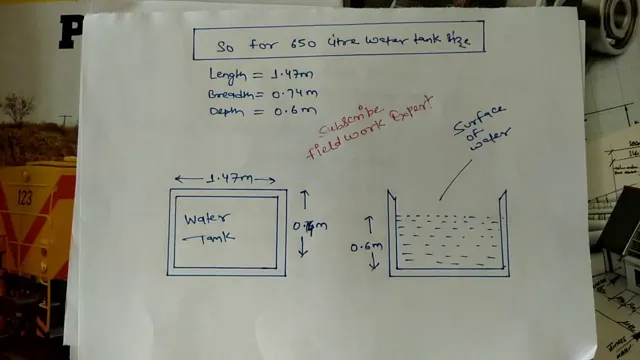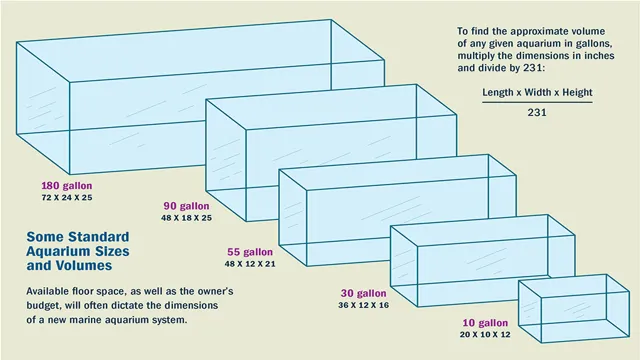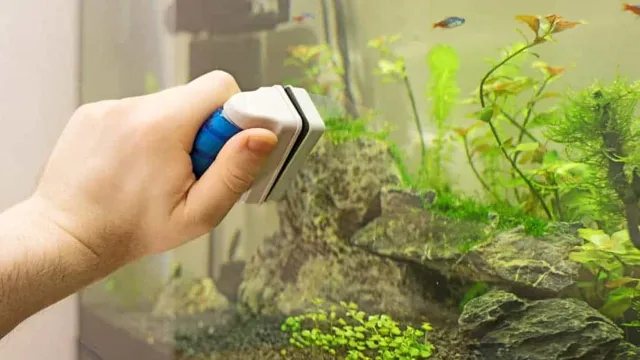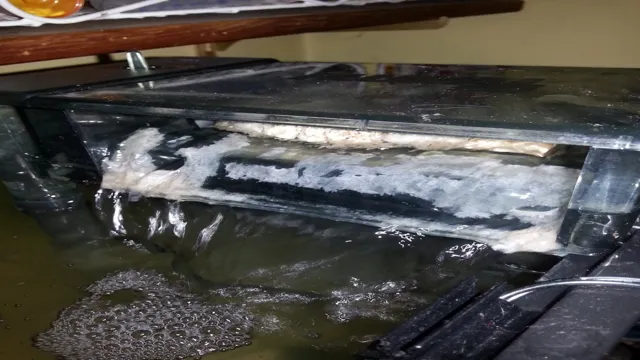Do you know how many gallons of water your aquarium holds? If not, don’t worry, you’re not alone! Calculating the amount of water in your aquarium may not be the most exciting aspect of fishkeeping, but it’s essential for maintaining a healthy aquatic environment for your underwater friends. In this blog post, we’ll explore easy ways to determine the size of your aquarium and calculate the number of gallons it can hold. We’ll also highlight the importance of knowing the approximate volume of your aquarium and how it can impact the health and well-being of your fish.
So, let’s dive into it!
What You’ll Need to Know
If you’re setting up a new aquarium or need to perform maintenance on an existing one, knowing how to calculate the gallons in your tank is essential. To get started, you’ll need to measure the length, width, and height of the aquarium, in inches. Once you have these measurements, you’ll multiply them together and divide the total by 231, which is the number of cubic inches in a gallon.
This will give you the total number of gallons in your aquarium. Additionally, you may need to account for the displacement of any rocks, decorations, or equipment in your tank, which can slightly affect the final gallon count. Knowing the exact number of gallons can help you properly dose medications, determine appropriate fish stocking levels, and maintain proper water parameters for your aquatic inhabitants.
It’s important to stay on top of regular water changes and testing to keep your aquarium healthy and thriving.
The Dimensions of Your Aquarium
When it comes to setting up a new aquarium, one of the most important things you’ll need to consider is the size and dimensions of your tank. Before you purchase any fish or equipment, you’ll need to know exactly how much space you have to work with. The size of your aquarium will impact everything from the number and type of fish you can keep, to the types of plants and decorations you’ll be able to add.
You’ll want to pay attention to both the physical dimensions of the tank (length, width, and height) as well as the total capacity (in gallons or liters) to make sure you’re getting the right size for your needs. Some factors to consider when choosing the size of your aquarium include your available space, your budget, and your level of experience with the hobby. Whether you’re looking for a small desktop tank or a massive showpiece, there’s an aquarium out there that’s perfect for you.

Converting Inches to Gallons
If you’re finding yourself tasked with converting inches to gallons, there are a few things you’ll need to know before getting started. One crucial piece of information you should be aware of is the density of the liquid you’re trying to measure. Different liquids have varying densities, meaning that the amount of space they take up within a container may not correlate directly with their volume.
For example, a gallon of water will take up more space than a gallon of oil due to differences in their densities. Additionally, it’s essential to be precise with your measurements. Even small discrepancies in the amount of liquid being measured can lead to large differences in the final result.
By keeping these factors in mind and utilizing a conversion chart or online calculator to ensure accuracy, you’ll be well on your way to successfully converting inches to gallons.
Calculating Gallons for Common Tank Shapes
Calculating the gallons of water in your aquarium is vital for knowing the right amount of water treatment, fish stocking, and maintenance required. The most common tank shapes include rectangular, cylindrical, hexagonal, and bow-fronted. To calculate the gallons of water in a rectangular tank, measure the length, width, and height of the tank in inches, multiply all the values, and divide the resulting number by 23
For cylindrical tank, measure the height and diameter and calculate the volume that is pi multiplied by the radius squared and then multiplied by the height, and divide the result by 231 to get the gallons. The same calculations apply for calculating water volume in a hexagonal tank or a bow-fronted tank. Understanding the water volume of your aquarium is crucial for maintaining a healthy environment for your fish. (See Also: How Strong a Heater for an Aquarium Do You Really Need: A Comprehensive Guide)
Rectangular Tanks
Calculating gallons for rectangular tanks is a critical skill for many applications. These tanks come in a variety of sizes and volumes, making it essential to know how many gallons they can hold. Fortunately, calculating gallons for rectangular tanks is relatively straightforward.
To find the volume of a rectangular tank, you need to measure the length, width, and height. Once you have these dimensions, multiply them together to find the total cubic inches. Next, convert this number to gallons by dividing the total by 231, which is the number of cubic inches in a gallon.
For example, a 72-inch long, 36-inch wide, and 48-inch high tank have a total volume of 124,416 cubic inches. After dividing this number by 231, you’ll find that the tank can hold approximately 538 gallons of liquid. Knowing how to calculate the volume of rectangular tanks can help you make informed decisions about tank sizing and capacity for industrial, agricultural, or residential needs.
Cylindrical Tanks
Calculating Gallons for Common Tank Shapes – Cylindrical Tanks When it comes to calculating the gallons of cylindrical tanks, it’s important to understand the basic formula for finding the volume. The formula is simple: V = πr²h, where V is the volume of the cylinder, r is the radius of the cylinder, and h is the height of the cylinder. Once you have these measurements, you can easily calculate the number of gallons your tank can hold.
For example, if you have a cylindrical tank with a height of 4 feet and a radius of 2 feet, you can use the formula above to determine the volume: V = 14 x 2² x 4 = 50.24 cubic feet.
To convert cubic feet to gallons, you will need to multiply by 48 (the number of gallons in a cubic foot). So, in this case, the tank can hold approximately 375 gallons of liquid (50.
24 x 48 = 3799).
It’s important to note that when measuring your tank, you should always measure the inside dimensions to get an accurate calculation. Additionally, the formula for finding the volume of a cylindrical tank can be used for both horizontal and vertical tanks. In conclusion, knowing how to calculate the gallons of a cylindrical tank is an important skill for anyone who works with these containers.
With the formula above, you can easily determine the number of gallons your tank can hold based on its dimensions. Always remember to measure the inside dimensions and use the appropriate units (cubic feet and gallons) when making your calculations.
Bowfront Tanks
Bowfront tanks are a popular choice among fish enthusiasts due to their elegant shape and unique appearance. However, when it comes to calculating the capacity of these tanks, things can get a little tricky. Unlike traditional rectangular tanks, bowfront tanks have rounded front panels that make measurements a bit more difficult. (See Also: How to Clean Calcium Off of Aquarium Parts: Tips and Tricks to Keep Your Tank Sparkling Clean)
Generally speaking, calculating the gallons of a bowfront tank involves measuring the length, width, and height of the tank and using a specialized formula to determine the volume. Additionally, it’s important to take into account the length and depth of the bowfront section, as this can affect the total capacity of the tank. By taking the time to properly calculate the number of gallons in your bowfront tank, you can ensure that your fish have enough space to live comfortably and thrive.
Calculating Gallons for Oddly Shaped Tanks
Calculating the number of gallons in a standard rectangular aquarium is a simple and straightforward process. However, what happens when you have an oddly shaped tank? Calculating gallons in such a tank may seem difficult, but it is not an impossible task. First, you need to measure the length, width, and height of your tank in inches, and take note of every crook and corner.
You can then use these measurements to determine the volume of water that it can hold by multiplying the tank’s length, width, and height in inches and then dividing by 231, the number of cubic inches in a gallon. The result will give you the number of gallons your uniquely shaped tank can take. Alternatively, you can use online calculators specially designed for such purposes.
These calculators only require you to input your tank’s dimensions, and they will calculate the number of gallons in no time. By using these methods, you can maintain a healthy and balanced aquarium environment for your fish and aquatic plants without hassle.
Dividing the Tank into Measurable Sections
When it comes to measuring the gallons in oddly shaped tanks, it’s important to take into account the tank’s unique shape. Dividing the tank into measurable sections can help you calculate the gallons more accurately. One method involves dividing the tank into various geometric shapes, such as rectangles or cylinders, to determine their individual volume.
You can then add up the volume of each section to get the total volume of the tank. Another approach involves using water displacement, which involves adding measured amounts of water to the tank and calculating the difference in water level. This method, however, can be more time-consuming and less accurate.
Overall, finding the best approach for calculating gallons in oddly shaped tanks takes some experimentation and careful consideration of the tank’s shape and dimensions. With some effort and patience, you can determine the accurate volume of your tank and keep your operation running smoothly.
Calculating Gallons for Each Measurable Section
Calculating gallons for oddly shaped tanks can be a challenging task for those who are not familiar with geometry and math. Oddly shaped tanks can have various curves, angles, and depths that require precise measurements to determine the correct gallon capacity. To calculate the gallons for each measurable section of the tank, one must first measure the dimensions such as the length, width, and height of the tank.
Then, for each section, multiply the measurement in feet (length x width x height) by 48, which is the number of gallons in a cubic foot of water. This will give you the total gallons for each section.
It’s important to note that measuring the tank accurately is crucial to ensuring that the correct amount of product is being stored and distributed. Using software or consulting with professionals can help simplify this process and ensure that the measurements are accurate, saving time and resources in the long run.
Conclusion
In conclusion, calculating the gallons in an aquarium is as simple as pie – if you know the right formula! By multiplying the length, width, and depth of your tank in inches and dividing the result by 231, you can easily determine the number of gallons your aquarium can hold. So forget about eyeballing it or guessing – use this easy calculation to ensure your fish and aquatic plants have the perfect, gallon-specific paradise to call home!” (See Also: How to Acclimate New Fish to Aquarium: The Ultimate Guide for Beginners)
FAQs
How do I calculate the volume of my aquarium in gallons?
To calculate the volume of your aquarium in gallons, measure the length, width, and height in inches. Then, multiply those three numbers together and divide by 231.
Can I estimate the amount of water in my aquarium without measuring it?
Yes, you can estimate the amount of water in your aquarium by using a water displacement method. Fill a container with water to a certain level, then carefully lower it into the aquarium. The water will displace some of the aquarium water, and you can measure how much was displaced to estimate the aquarium volume in gallons.
Do I need to factor in the weight of decor and substrate when calculating the volume of my aquarium?
No, the weight of decor and substrate won’t affect the volume of your aquarium. However, if these items displace water, then you’ll need to factor that in to accurately calculate the water volume.
Why is it important to know the volume of my aquarium in gallons?
Knowing the volume of your aquarium is crucial for dosing medications and other water additives correctly, as well as maintaining appropriate stocking levels and filtration.
Can I use Google to convert liters to gallons for my aquarium?
Yes, you can use Google or another online conversion tool to convert liters to gallons. Simply type in the number of liters you have, and the tool will provide the equivalent value in gallons.
What’s the easiest way to measure the length, width, and height of my aquarium?
The easiest way to measure your aquarium is with a tape measure or ruler. Make sure to measure in inches for accuracy.
How often should I recalculate my aquarium volume in gallons?
You should recalculate your aquarium volume whenever you make significant changes to its dimensions or water level. Otherwise, it’s a good idea to recalculate once every few months as a general check.







